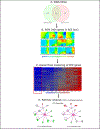Systems Modeling of Developmental Vascular Toxicity
- PMID: 32030360
- PMCID: PMC7004230
- DOI: 10.1016/j.cotox.2019.04.004
Systems Modeling of Developmental Vascular Toxicity
Abstract
The more than 80,000 chemicals in commerce present a challenge for hazard assessments that toxicity testing in the 21st century strives to address through high-throughput screening (HTS) assays. Assessing chemical effects on human development adds an additional layer of complexity to the screening, with a need to capture complex and dynamic events essential for proper embryo-fetal development. HTS data from ToxCast/Tox21 informs systems toxicology models, which incorporate molecular targets and biological pathways into mechanistic models describing the effects of chemicals on human cells, 3D organotypic culture models, and small model organisms. Adverse Outcome Pathways (AOPs) provide a useful framework for integrating the evidence derived from these in silico and in vitro systems to inform chemical hazard characterization. To illustrate this formulation, we have built an AOP for developmental toxicity through a mode of action linked to embryonic vascular disruption (Aop43). Here, we review the model for quantitative prediction of developmental vascular toxicity from ToxCast HTS data and compare the HTS results to functional vascular development assays in complex cell systems, virtual tissues, and small model organisms. ToxCast HTS predictions from several published and unpublished assays covering different aspects of the angiogenic cycle were generated for a test set of 38 chemicals representing a range of putative vascular disrupting compounds (pVDCs). Results boost confidence in the capacity to predict adverse developmental outcomes from HTS in vitro data and model computational dynamics for in silico reconstruction of developmental systems biology. Finally, we demonstrate the integration of the AOP and developmental systems toxicology to investigate the unique modes of action of two angiogenesis inhibitors.
Keywords: 5HPP-33; Adverse outcome pathway; TNP-470; Tox21; ToxCast; angiogenesis.
Figures




Similar articles
-
Embryonic vascular disruption adverse outcomes: Linking high-throughput signaling signatures with functional consequences.Reprod Toxicol. 2017 Aug;71:16-31. doi: 10.1016/j.reprotox.2017.04.003. Epub 2017 Apr 13. Reprod Toxicol. 2017. PMID: 28414088
-
Data-driven derivation of an adverse outcome pathway linking vascular endothelial growth factor receptor (VEGFR), endocrine disruption, and atherosclerosis.ALTEX. 2024;41(4):617-632. doi: 10.14573/altex.2403211. Epub 2024 Jul 8. ALTEX. 2024. PMID: 38979646
-
Embryonic vascular disruption adverse outcomes: Linking high throughput signaling signatures with functional consequences.Reprod Toxicol. 2017 Jun;70:82-96. doi: 10.1016/j.reprotox.2017.05.005. Epub 2017 May 17. Reprod Toxicol. 2017. PMID: 28527947 Free PMC article.
-
Predictive models and computational toxicology.Methods Mol Biol. 2013;947:343-74. doi: 10.1007/978-1-62703-131-8_26. Methods Mol Biol. 2013. PMID: 23138916 Review.
-
Application of ToxCast/Tox21 data for toxicity mechanism-based evaluation and prioritization of environmental chemicals: Perspective and limitations.Toxicol In Vitro. 2022 Oct;84:105451. doi: 10.1016/j.tiv.2022.105451. Epub 2022 Jul 31. Toxicol In Vitro. 2022. PMID: 35921976 Review.
Cited by
-
Navigating the Minefield of Computational Toxicology and Informatics: Looking Back and Charting a New Horizon.Front Toxicol. 2020 Jun 25;2:2. doi: 10.3389/ftox.2020.00002. eCollection 2020. Front Toxicol. 2020. PMID: 35296116 Free PMC article. No abstract available.
-
The liver, a functionalized vascular structure.Sci Rep. 2020 Oct 1;10(1):16194. doi: 10.1038/s41598-020-73208-8. Sci Rep. 2020. PMID: 33004881 Free PMC article.
-
Application of In Vitro Metabolism Activation in High-Throughput Screening.Int J Mol Sci. 2020 Oct 31;21(21):8182. doi: 10.3390/ijms21218182. Int J Mol Sci. 2020. PMID: 33142951 Free PMC article. Review.
-
Human Cell-Based in vitro Phenotypic Profiling for Drug Safety-Related Attrition.Front Big Data. 2019 Dec 11;2:47. doi: 10.3389/fdata.2019.00047. eCollection 2019. Front Big Data. 2019. PMID: 33693370 Free PMC article.
-
Bringing Big Data to Bear in Environmental Public Health: Challenges and Recommendations.Front Artif Intell. 2020 May;3:31. doi: 10.3389/frai.2020.00031. Epub 2020 May 15. Front Artif Intell. 2020. PMID: 33184612 Free PMC article.
References
-
- Chung AS and Ferrara N, Developmental and pathological angiogenesis. Annu Rev Cell Dev Biol, 2011. 27: p. 563–84. - PubMed
-
- Maltepe E and Simon MC, Oxygen, genes, and development: an analysis of the role of hypoxic gene regulation during murine vascular development. J Mol Med (Berl), 1998. 76(6): p. 391–401. - PubMed
-
- Carmeliet P, Angiogenesis in life, disease and medicine. Nature, 2005. 438(7070): p. 932–6. - PubMed
-
- (••) Knudsen TB and Kleinstreuer NC, Disruption of embryonic vascular development in predictive toxicology. Birth Defects Res C Embryo Today, 2011. 93(4): p. 312–23. - PubMed
Grants and funding
LinkOut - more resources
Full Text Sources
